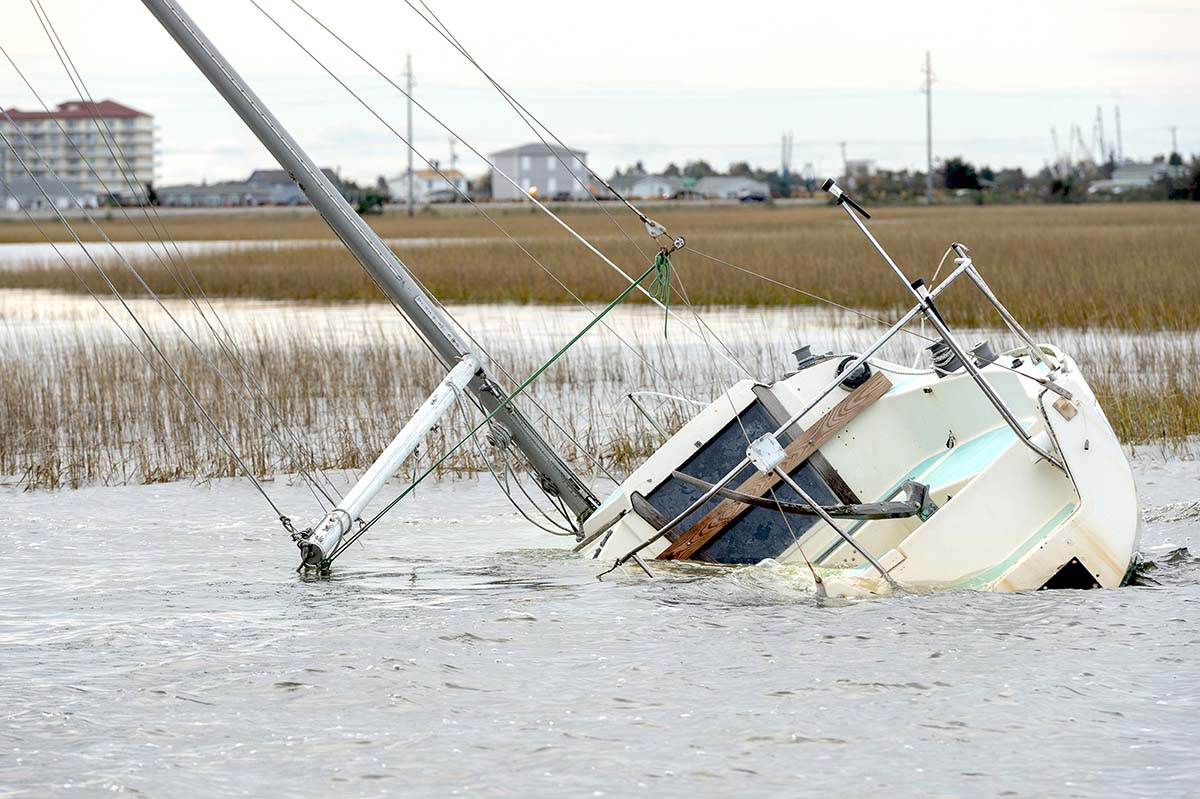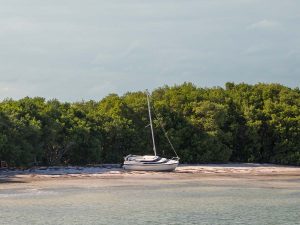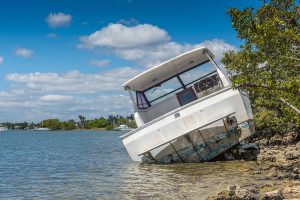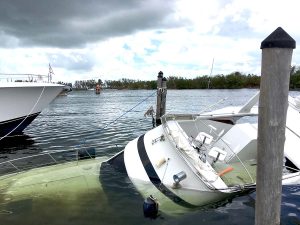
ADVs: A Growing Problem Without an Easy Solution
Published on October 24, 2025Abandoned and derelict vessels (ADVs) are nothing new. The ghost ships and graveyards of long-sunken boats dot many coastal areas. But while there was a mystique to finding the

Edmund Fitzgerald or Blackbeard’s ship, the boats found today are simply leftover 30-footers of owners who were unable or unwilling to pay for their proper disposal. As more boats are left to rot in marshes, bays, sounds and rivers, creating navigation and environmental hazards, programs are springing up to combat the problem. Two such programs come from Washington and the BoatUS Foundation.
Washington Program Shows Promise
The state of Washington has been a leader in vessel removal, having created legislation for the Derelict Vessel Removal Program through its Department of Natural Resources in 2002. Since then, more than 1,200 ADVs have been removed from Washington waterways.
Troy Wood, program manager for the Derelict Vessel Removal Program, Aquatic Resources Division, Washington State, said the program accepts both commercial and recreational vessels, which have vastly different recovery processes.
There is currently a 170-foot-long steel fish processing vessel slated for removal at an estimated disposal cost of about $3 million. Conversely, the recent capture of 15 smaller vessels, removed by helicopter, cost $3,400 each.
No matter the size or type, each boat is inspected for hazards, which are removed if found, and then the deconstruction of the boat is put out to bid. Wood said the chosen contractor will do another inspection to remove anything salvageable and recyclable before the boat is finally destroyed.
“We don’t want boats just crushed and put in landfills. We’re not in the business of taking trash out of the water and then just putting it on land,” Wood said. “We want to recycle as much as possible. A local recycling company, DTG Recycling, accepts a lot of fiberglass, which is used to create the BTUs for the manufacturing of paper and concrete.”
While other states have implemented ADV removal programs, Washington’s has stood out as a model of efficiency and effectiveness in not just removing ADVs but in working to prevent boats from being abandoned.
In 2020, the Washington Legislature adopted SB6528, adding tools to increase the ADV program’s effectiveness. Included in the package was a vessel turn-in program that allows boat owners to voluntarily hand over their boats if they can no longer care for them or pay to dispose of them. There is no charge to the boat owner. “It’s a lot cheaper for them to give it to us than for us to get it out of the sound,” Wood said. “We minimize the initial impact to the environment that a derelict vessel will cause.”
Another proactive part of the 2020 legislation stems from secondary liability. “We don’t want people to dump their boats that have reached the end of their useful life on some unsuspecting person who doesn’t realize how much work the boat needs,” Wood said. If a boat is older than 40 years and more than 35 feet long, the state requires an inspection upon registration to ensure the boat’s seaworthiness before it can be sold. Prior to 2020, this program only applied to boats over 65 feet long.

In addition, the DNR is authorized to ticket boats that are not properly licensed or registered with the state, and sellers are held liable for the costs of recovering abandoned vessels if they are the last found owner. “If a seller claims they’ve sold an ADV, we require proof of transfer of ownership, or they’re responsible for the cost,” Wood continued.
The Derelict Vessel Removal Program is not cheap to operate, with a total budget for 2025 to 2027 of $17.1 million. The funding is broken down as follows:
$8.1 million – Watercraft Excise Tax or WET (Source: revenue from state sales tax)
$2 million – Derelict Vessel Removal Account or DVRA (Source: recreational vessel registration fee; commercial vessel fee)
$1 million – Marine Debris Removal Grant (Source: NOAA)
$6 million – Capital Funds for Large Vessel Removal (Source: state capital budget)
While Washington’s program has shown much success, having removed about 200 vessels annually, the number of reported ADVs continues to grow. The program has an inventory of ADVs, ranked in priority from 1 to 5 based on the threat to safety and the environment. The vessels added to the inventory are reported by the public, law enforcement, the U.S. Coast Guard, or anyone who comes across an ADV.
BoatUS Foundation Looks Nationally
On a national scale, the number of ADVs multiplies exponentially. Discovering just how big the problem has become is part of the mission for the BoatUS Foundation, which secured a $10 million NOAA Marine Debris Program grant to create a national database of ADVs. The grant also sets aside funds for BoatUS to administer a grant program for vessel removal and to develop an educational conference to share experiences and strategize for solutions.
Alanna Keating, director of outreach for the BoatUS Foundation, said the program has been in existence for 15 years, but it started on a much smaller scale, targeting individual communities. This year was the first time the level of funding was significant enough to allow for the distribution of grants, establishing the ADV database, and holding a conference entitled Turning the Tide.
The ADV database is an initial attempt to quantify the ADV problem on a national level. Different states have collected information on the number of boats they believe they have, but those numbers have never been combined, nor has there ever been a look at whether the number of boats is increasing or by how much. “Right now we’re seeing a lot of boats that were built in the ‘70s as they age out of being functional. But as more boats have been sold and without a sustainable solution for disposal, the chances of more ADVs coming online continue to increase,” she said.
The big news for the program this year was the release of $7.5 million in funding for 10 removal projects, located in five states, two territories, and within one tribe. The projects were reviewed by a committee and scored based on the following general criteria:
Demonstrate strong community support
Include input from and benefit tribal, underserved, or low-income communities
Benefit marine animals, their habitats, local communities or local economies
Keating said that while the 10 projects chosen represent a major step, they received $44 million in requests for funding. “It’s challenging to get it down to just those 10 based on our criteria and scoring, with the top scoring awarded the funds,” she said. “There were significantly more well-deserving projects we just couldn’t fund.” She pointed out that the grant is only for coastal projects right now, with nothing available for inland ADV removal, although the problem is just as prevalent on lakes and rivers.

The BoatUS Foundation will work with the grant awardees over the next two years to do the removal work. “Saying we have the money is the easy part. We’re hoping this winter, depending on weather and compliance, we’ll be doing the removal efforts and noting the impacts. We’ll release information as we go on what we’re learning and opportunities for others to be involved,” she said.
One of the biggest challenges is how to dispose of the vessels once they are removed. Grantees must address that in their grant applications to ensure boats don’t end up in landfills. Keating explained that there isn’t one solution that will work for every situation, but progress is being made on recycling through the efforts of organizations like RI Marine Trades Association and Carbon Rivers in the United States and Blue Parameters in the U.K. “It’s a global issue, and we are sharing information to keep us all moving in the right direction. There are exciting advances happening,” Keating said.
Exploring what advances are occurring in boat disposal is one of the BoatUS goals for holding an annual conference. This past February, the organization launched the “Turning the Tide” virtual conference and will continue the conversation at an in-person conference in New Orleans in 2026. The event is targeted for state and local government personnel looking to address ADV and disposal options, students wanting to learn more about the issue and innovators who may have ideas for solutions. “The event is open to anyone who finds value in exploring the options and moving it forward,” Keating said. “On a federal level, NOAA, EPA, USCG and the Corps are all impacted by ADVs, so we hope to attract those agencies and keep the issue top of mind.”
Keating said the ADV problem cannot be solved by governments and grants alone, and she is hoping to gain widespread industry support. “The biggest takeaway is there’s no quick solution and no single organization that can make a lasting and significant enough impact. This is on the verge of being a major global problem for us to address together,” she said, also commenting that the state successes in places like Washington are being built off lessons learned in other states and countries. She sees the BoatUS Foundation’s role as bringing everyone together to find solutions and work towards prevention.
| Categories | |
| Tags |





